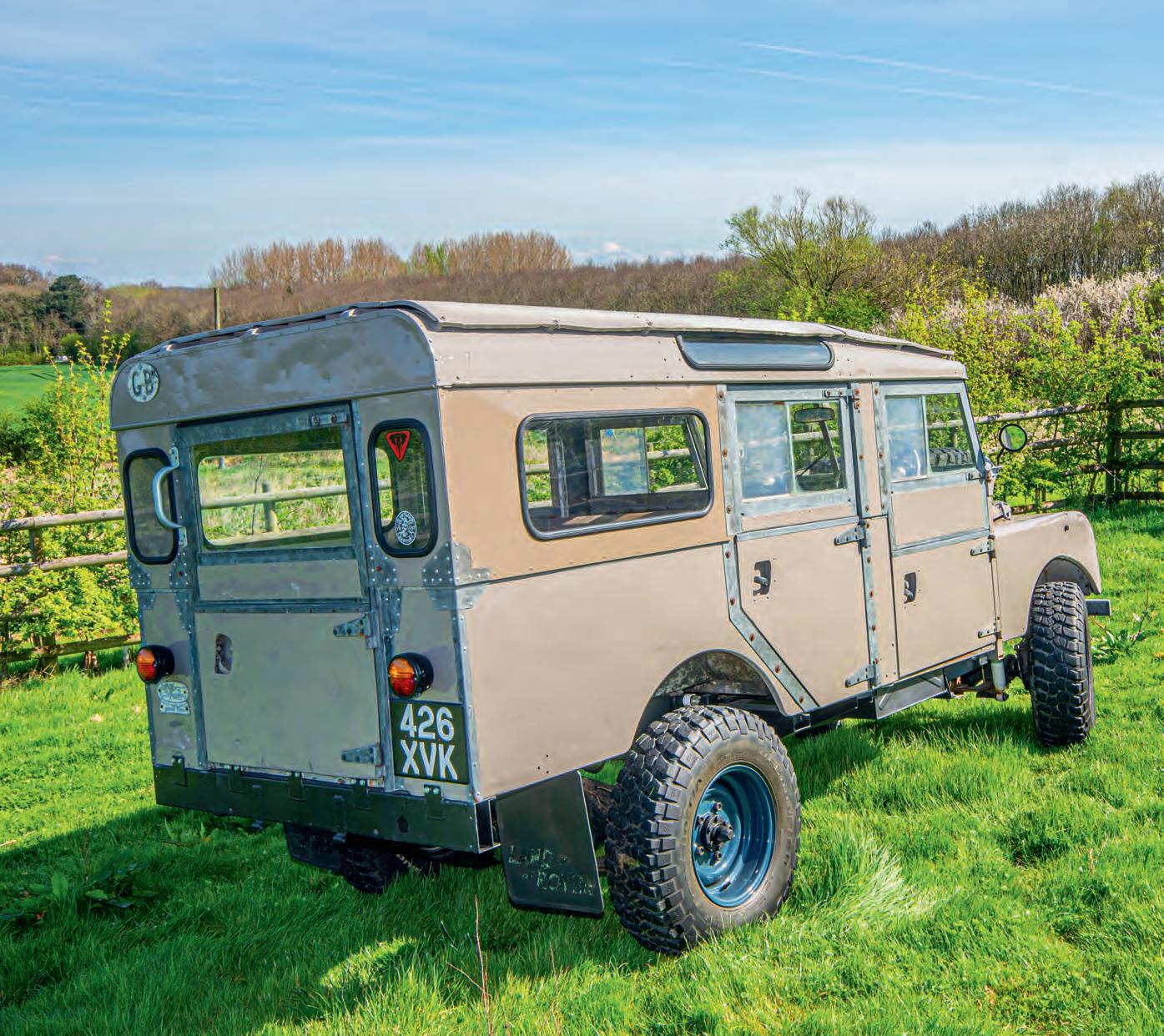
10 minute read
Restifi ed 107 A classic Land Rover rebuilt to be a modern work truck

This is not a classic.
Advertisement



Words and pictures: Dan Fenn

We don’t do much about historic Land Rovers in these pages. But while a 107” Series I Station Wagon is one of the most sought after classics of them all, that’s not what this is. It’s an original 107 alright – but it’s been reimagined as a truck you can use today, and every day stretching out into the future. You won’t see it looking shiny in the concours at a show – but it could crop up doing a job of work literally anywhere else

What does a Series I Land Rover have to do with off-roading in the real world these days? It’s a reasonable question, given the astronomical prices they have long since started to command on the classic car market.
Well, the one you’re looking at here has the answer. Or maybe it is the answer. Either way, it’s not the usual sort of Series I you see nowadays, restored to squeaky-clean perfection and fi t only for sunny Sunday drives and trailering to shows for static display in the concours.
On the contrary, it’s been rebuilt rather than restored, with a view to being an everyday classic rather than a museum piece. A historic Land Rover, yes, but one which can tow, carry and get covered in mud and worse with the best of them.
‘This is not one for the purist,’ says Matt Moore, owner of Historic Motoring Solutions. ‘It’s more for a discerning motoring enthusiast who wants something useful and unique.’
He’s talking about a Series I 107” Station Wagon dating from 1957. It started life by being exported to Australia and was among a batch of several brought back to the UK a few years ago in response to the astronomical prices the earliest Land Rovers had begun to command.
Land Rover itself was at the heart of this, with its own restored Series Is leaving the factory for six-fi gure sums. These examples were very much

the back-to-showroom kind, however, with every last wear mark painstakingly burnished out of them – along, you might say, with every last scrap of character.
Anyway, that’s very much a debate for another day. The point is that with this going on at the top of the market, independent specialists like Matt needed to chase after another kind of Land Rover buyer – the kind to whom buying a classic offroad vehicle is something you do with your heart and soul, not your financial advisor and investment portfolio manager.
Heart and soul… and head, too? Yes, for sure. As Matt says, this is a vehicle for someone who wants a Series I they can use, and he restored it with just that purpose in mind.
It was a ground-up job, as they usually need to be. Vehicles from Australia tend not to be rusted to death, but Matt started with a new galvanised chassis from Richards anyway, adding a rebuilt bulkhead to put himself in a rock-solid base camp.
To turn the chassis into the rolling variety, he added a set of Stage 1 axles – fully restored themselves, of course, complete with rebuilt swivels and brakes. These are shod with 265/75R16 BFGoodrich Mud-Terrains on deep-dish steel rims and hold the vehicle up using a set of parabolic springs paired with new shocks.
If you’re the aforementioned purist, by now you’ve either stopped reading or passed out at the sheer horror of it all. Which is just as well, because next came a 200Tdi engine. Taken from a
The seats have been retrimmed in Tenghi upholstery from Exmoor Trim, with the same material also covering the door panels. The bulkhead, meanwhile, is lined in Dynamat, which comes over as quite a heroic thing to do. Up top, the roof lining has a patina all of its own; there’s no danger of the vents for the Safari roof being blocked, that’s for sure. Just so long as there aren’t any spiders living in it… If you’re the kind of person who thinks a classic Land Rover should be ‘right’, you’ll find this very wrong. The 200Tdi engine is a wonderful thing, and so is the 107 Station Wagon, so a 107 Station Wagon with a 200Tdi had got to be more wonderful than ever, right? Discuss…

Discovery, this was fitted minus its intercooler on the basis that there wasn’t room for it. The donor vehicle’s power steering wasn’t used, either, which sounds like a recipe for forearms like Popeye – though as we found when we had a spin in the vehicle, it’s actually surprisingly light to manoeuvre even at low speeds.
Behind the engine is a four-speed Series IIA gearbox. This gives you syncromesh in every ratio, though first you have to find one – which with the absolutely gigantic throw on the stick is definitely an acquired skill. One that’s well worth the time to acquire, though, because for all the effort you have to put into it the sheer pleasure that comes from bonding with an old stager like this is simply incomparable.



We’d love it even more if the bodywork still had the patina of 65 years in the Outback, but this one has been painted – albeit not to the sort of over-prepped level that neutralises a vehicle’s entire character. The body cappings haven’t been re-galvanised, either, which helps connect it to the life it’s lived to date.
Inside, the seats and doors were retrimmed in Tenghi upholstery from Exmoor Trim and there’s a liberal amount of Dynamat in the footwells, though whether the latter makes any difference is hard to quantify. To us, it’s hard to believe that it could be any louder in the cabin when you press the button and the Tdi lump clatters into life. It’s noisy, it’s rattly and we like it just the way it is.
We also like, make that love, the daylight that’s visible through the fl oor at either end of the bulkhead behind the front seats. It would be unthinkable in a Defender, but in a 107 it’s simply correct. As Matt puts it, ‘the rest of the inside is original and patinated.’
This includes the head lining, which to be fair is very patinated indeed. So much so that having spent 65 years in Australia, we’d be taking precautions in case there were dodgy spiders living in it. What it does have, though, is access holes to vents from the Safari roof – always a lovely period item on a Land Rover from this era.
Would it be better if all these items were back to the way they were when they left the factory? In some people’s eyes, maybe, yes. And some of those people might tolerate all the non-standard parts on the vehicle, too. Perhaps it would be worth more with its original engine, box, axles and so on, especially if you were to do a just-so resto on it and take it back to the way it was on day one. But as we always say, it’s the history that makes a classic, and history is a living thing.
And this is still very much a living Land Rover. Matt didn’t rebuild it this way just so it could sit in a museum. ‘It’s an absolute head turner,’ he says. ‘It would be a great tow truck for a period racing car (and he’s got plenty of knowledge of that scene), ‘or just for fun days out.’
And how right he is. It might not be one for the purist, but this is a Series I with a whole lifetime still to be lived. And for whoever takes it on, it’s going to be a lifetime of smiles aplenty.

Thanks to Historic Motoring Solutions for their help in compiling this article. You’ll fi nd them at www.historicmotoringsolutions.com















2023 PICK-UP


OF THE YEAR

IT’S A FUNNY OLD TIME IN THE PICK-UP MARKET. As we write this, the new Ford Ranger is right on the verge of going on sale. It will be followed during the coming year by the mechanically similar Volkswagen Amarok. And something will be very far wrong if the effect is anything other than game-changing.
So there’s a real sense of anticipation among people who buy pick-ups. That’s the case at the workhorse end of the market and the premium level alike; Volkswagen will aim squarely at the latter, while Ford will try to cover every base. However this anticipation is tempered by concern at what’s happening in the economy; these new vehicles will cost signifi cantly more than those they replace, at a time when we have signifi cantly less to spend on them.
So the vehicles contesting this year’s Pick-Up of the Year awards will continue to matter as much as ever even after the new Ranger and Amarok arrive. Value for money has always been important, but business and individuals will be looking more than ever to make every penny count. And this comes against a background of price rises during the last 12 months which have seen some manufacturers hike their list fi gures by even more than the rate of infl ation.
Neither of the newcomers was available for testing in time to be included in these awards, so with the old Ranger effectively discounted it’s a three-way battle between the Isuzu D-Max, Toyota Hilux and SsangYong Musso. Changed days from when there were nine different vehicles fi ghting it out. The Hilux is the reigning champion but it has seen the biggest price climbs since last year, while the Musso has had the most modest. SsangYong has revised its vehicle’s engine, which now produces more power and torque while using less fuel; Isuzu and Toyota have introduced new models in the D-Max AT35 and Hilux GR Sport, and the former has also revised its range structure by making automatic transmission and a locking rear diff available on utility-spec versions of a truck whose popularity with work-focused users remains as great as ever.
What will the landscape look like next year? Rather different, it’s safe to assume. Mind you, we assumed that last year too. For now, there may be less models in it right now but the new pick-up market remains as buoyant as ever.






2023














